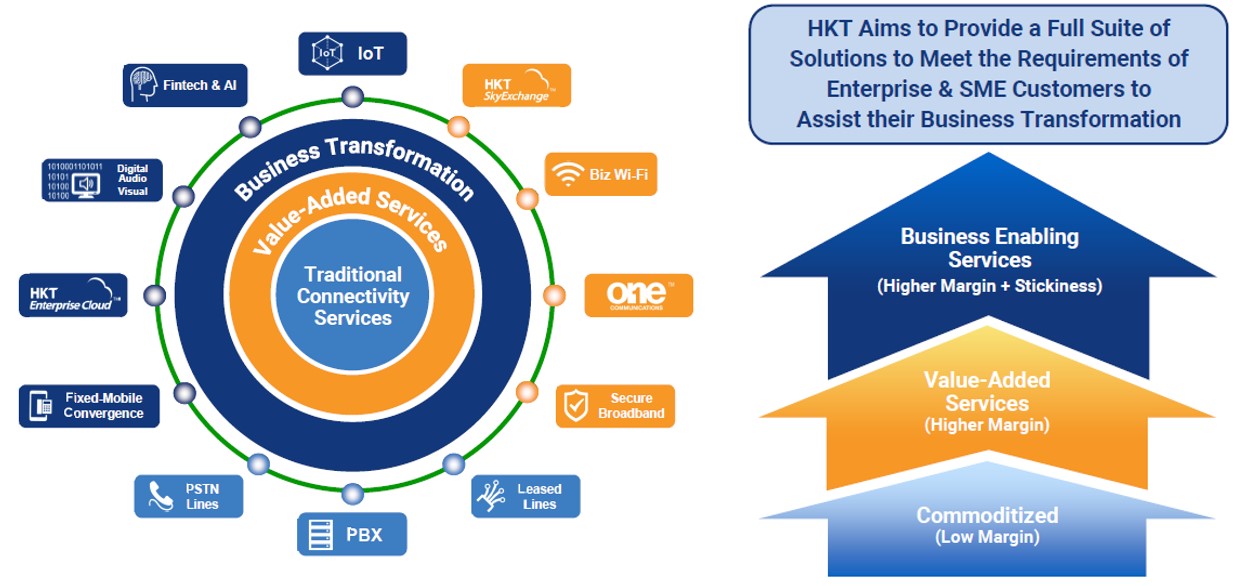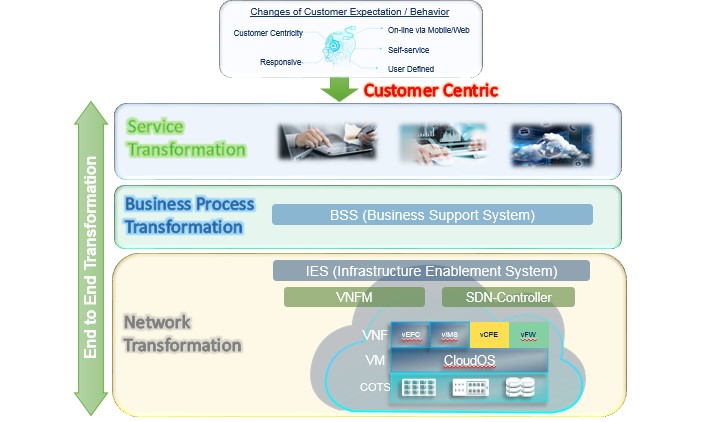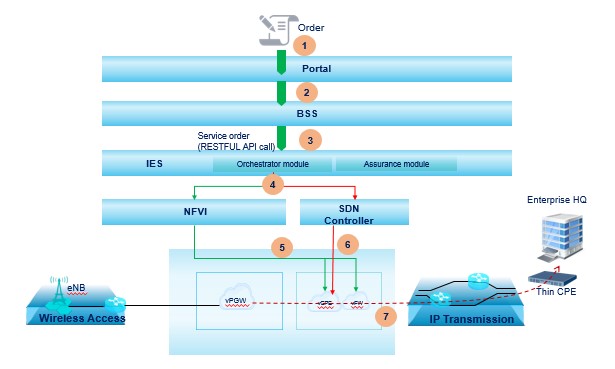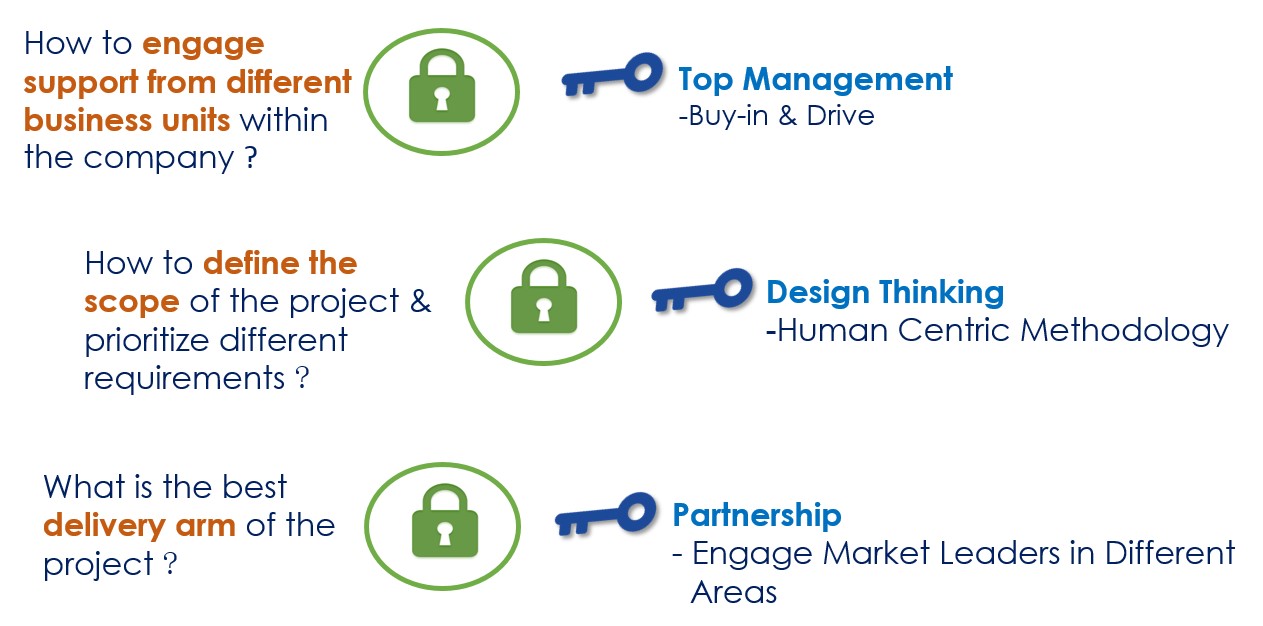Digital Transformation for Business Growth
Communication Service Providers (CSPs) nowadays are facing increasing challenges due to changes in customer behavior as well as competitions from OTT players in terms of service innovation, time-to-market and customer service experience. In order to sustain continuous business growth and to maintain competitive edges in the market, CSPs have to embark on and commence their digital transformation processes to different extents.
HKT Limited is the premier full service CSP having its business in the hyper-competitive telecoms market of Hong Kong. To maintain market leadership position and to drive sustainable growth, HKT needs to transform into a Digital Service Provider with best customer experience to compete against not just with traditional players, but OTT players that have the level of agility, cost efficiency and customer experience not matched by CSPs today.
To mitigate the risk of such a large scale and complex end-to-end transformation, HKT employs a Greenfield approach to start its Digital Business Transformation Project with Enterprise market on selected products.
Peter Lam, Managing Director of HKT Engineering
Transformation Objectives
Nowadays, customers are surrounded with / immersed by digital experience from services offered by different digital services providers (e.g. banking, airlines and OTT players). Being accustomed to these digital experience, customer now expect the same (service experience) from CSPs like HKT. Customers are looking for service experience that is ‘real-time’, ‘online’, ‘on demand’, ‘self-serve’, and wants to stay connected to their social circles to share views and experiences. As such, HKT has no choice but to move forward and transform itself from a traditional CSP to a Digital Service Provider to meet the “transformed” customer expectations.
On one hand, the telecom industry is indeed moving from connectivity-based offerings to service-based offerings in an attempt to counteract the falling revenue trend of traditional telecom products. HKT needs to make itself ready and provide agile solutions to meet the requirements from customer and assist their business transformation.

Figure 1 – Transformation to Meet Modern Business Needs
On the other hand, applications of IoT, big data, virtual reality (VR), augmented reality (AR), artificial intelligence (AI), and connected vehicles will become popular in the near future. With the announcement of the Smart City Blueprint by the Hong Kong Government in Dec 2017 envisioning to build Hong Kong into a world-class smart city, HKT believes that its digital business transformation will enable the company to better capture these new business opportunities.
As such, the Main Objectives of HKT’s Digital Business Transformation are:
1. Offering Digital Service Experience to customers by changes existing customer engagement / support process from manual and offline mode into all-online, real-time and self-service mode,
2. Minimize the cost to serve and improve operations efficiency, so as to enable further downward penetration of the enterprise market to capture business opportunities in the Medium/SME markets which would otherwise unable to serve cost due to the limited scalability of human work force,
3. Improve Agility in terms of service of (i) service creation : to support more flexible product and offer definition, reduce the product time-to-market, enabling rapid new service development to capture market opportunities, and, (ii) service delivery / fulfillment : to integrate customer engagement with network provisioning / orchestration to enable fully automation of service fulfillment.
What Do We Transform?
To meet these objectives, HKT undertakes an End-to-End digital business transformation, named ‘Project Earth’ which cuts across Service Transformation, Business Process Transformation and all the way down to the Network / Infrastructure Transformation, aiming to deliver customer centric experience in the whole customer journey with agility in service creation.
Service Transformation: Consolidate HKT’s legacy and siloed B/OSS platforms of different lines of businesses into one single modernized B/OSS platform allows agile service delivery and cross product innovation across HKT’s different line of business. Besides, this also results in reduction of IT/System Opex and Capex spend (due to elimination of HKT’s legacy and slio B/OSS) plus increase in operational agility.
Business Process transformation: Simplify the customer engagement journey through use of digital channels, self-service, rapid service provisioning and delivery with the majority of new process flows being either automated or enabled for customer self-care. The use of on-line digital engagement reduces significantly the turnaround time of the traditional customer engagement with paper and manual process, and minimizes the possible human mistakes during the manual handling. Rework is eliminated which in turns increases the efficiency of account servicing and promotes customer satisfaction.
Network / Infrastructure Transformation: Cloudification of traditional networks with SDN and NFV technologies to allow rapid and flexible service creation and service delivery to meet market requirements. Through the orchestration layer between the network and the B/OSS, fast deployment and re-configuration of the network can be realized with service orchestration which automates manual process by opening up the network capabilities as APIs to the B/OSS so that online and real-time experience can be realized.

Figure 2 – End-to-End Transformation
Strategy and Project Phasing
As “Project Earth” cut across Service Transformation, Business Transformation and all the way down to Network / Infrastructure Transformation while at the same time impacting HKT’s all line of business, it would be far too risky to perform such a big bang transformation involving a large number of live customers especially when the concerned technologies (SDN / NVF) are still at their early stages and there is simply lack of standards for Digital Transformation implementations.
Therefore, HKT decided to take on a Greenfield approach to setup an all new Cloudified Network and Service Platform to support the newly transformed services and to start off with business segment of the enterprise market as a pilot for the transformation project. The decision comes with 2 major considerations: (i) the service models of enterprise market are more complex than that of consumer market, and hence if transformation work for enterprise market, it will be relatively easy to rollout to consumer market; and, (ii) the rollout to enterprise market can be controlled with customer-by-customer and service-by-service without the need for big-bang implementation as if consumer market. Hence HKT can better manage the risk by testing the new platform capabilities with a smaller groups of customer batch-by-batch.
With the above in mind, the planning and design phase focusing on the enterprise market segment started in 2016. HKT has selected 3 products in the Enterprise market to work on in the 1st phase of the project, they are:
Commercial mobile, which includes features like private network access, usage differentiation among personal / company use for BYOD, IoT related features;
Cloud-based services including IaaS and SaaS, this can include big data analytic solutions;
One Communication, which is a comprehensive unified communication service based on IP Centrex technology and broadband access.
Implementation for these 3 star products in the enterprise market segment is from 2017 till Q3 2018. Rest of the enterprise market segments will be transformed from 2nd half of 2018. A similar digital transformation process for the consumer market will be kick-started from 2019 onwards. The company-wide digital transformation project will take more than three years to fully realize.

Figure 3 - Phasing by Customer Segment / Service
After the strategy is confirmed, HKT started the project by analyzing the current ‘pain-points’, discovering service requirements of enterprise customers by walking through the customer journey from an “outside-in” perspective using a “design thinking” approach, bridging the customer expectation gaps with the traditional “inside-out” process based customer journey design. The result forms the basis of the required operation and network transformation in different areas to streamline business operations through enhancement of business and operations support systems, business processes, ICT infrastructure cloudification and virtualization. With the redesigned customer journey, HKT expects this delivers the business agility to offer customer-centric solutions and services.
Mobile CloudVPN Service as an Example
Mobile CloudVPN is a first of its kind, fixed-mobile convergent digital transformed product that is realized on cloud based network to utilize the capabilities of SDN and NFV technologies.
With the use of SDN and NFV technologies, network resource can be created real-time, on-demand on the virtualized mobile core network (NFV), while the CPE and Firewall features of the metro connection are configured and realized in the cloud network located at data center. This eliminate the need for complex setup and configuration at the customer premises which greatly reduce the service provisioning time.
To subscribe the service, Account Manager to input service requirements (such as topology, site configuration, bandwidth and etc.) to the online portal, where the orders will be issued to the network via the orchestration layer which then instructs and orchestrates the NFVI layer to create the network resources (vCPE and vFirewall), and put through the tunnel connection by sending commands to SDN.
With the above, HKT has achieved following benefits:
1. Highly productize the service by transforming the solution from manual supported mode with long lead time into all online subscription and activation and fully automatic service provision / delivery; minimizing the cost to serve which allows HKT to extend the business to SME market,
2. Provide online and self-service portal for enterprise customers to view and manage their own service experience,
3. Support seamless simultaneous orchestration between PNF and VNF,
4. With the use of thin CPE at customer premises while leaving the complex functions, i.e. vFW, vCPE, at cloud network and configure by the orchestration layer, this minimizes the field resource (technician) on site and eliminates human error(s) during service provisioning.

Figure 4 – Illustration of the Mobile CloudVPN Service
Overcoming the Transformation Challenges
During project implementation, HKT has experienced a number of challenges such as how to define the project scope and project phasing, how to make the business case sound, how to utilize latest technologies and at the same time ensure future proof, do we have sufficient and suitable resources to handle the project of that scale and complexity, and most importantly, how to get the support from different business stakeholders to support the transformation. Below highlighted some of them and HKT's tactics to overcome.
As digital transformation involves the entire customer journey, one big challenge is about the engagement of different stakeholders from different business units within the company. To drive that change, senior management are all committed to the project where HKT Group MD serves as the Executive Project Sponsor MD of Engineering as Project Sponsor and Head of Strategic Wireless Technology & Core Network as Project Director to help driving the project. As soon as the Business Strategy has been agreed between the GMD and senior management team, management staffs of different stake holder functions / business units all joined the project team as key members to support the project implementation and to make sure the project goes smoothly.
HKT makes use of the Design Thinking Methodology to help defining the value of transformation, identifying project scope, goals and transformation direction. Design thinking is a human-centric approach to problem-solving that integrated the needs of people, the possibilities of technology, and the requirements for business success. The project team analyzes the project requirement and works out the solution in 2 angles, “Outside-in” and “Inside-out”. Outside-in, focusing on Customer Experience Design, to identify customer requirements, design a new Omni-customer Journey and validating new product experiences for users. Inside-out, designing the new blueprint architecture, bringing in the all-new cloud network and a new operating platform.
For the technical side, the detailed design of data structure and the digital operations platform is no doubt a challenging task, and there is no standard or best practice for HKT to use as a reference point. Data is an important element in today’s digital world; it plays an important role in the customer journey management. This includes logging down details of personal interest or customer experience at different customer touch points. Today, HKT has a big data engine to manipulate a high volume of data; but the legacy data structure does not fit today’s needs. Therefore, HKT needs to adopt a Greenfield approach towards data structure and system design to “unify” the data.
In terms of personnel supporting the project, HKT establishes a dedicated Project Management Team to oversee the project implementation and uses a virtual team approach with experts from different area to support the project. As this is a huge and complicated project with a lot of new technologies introduced, HKT needs to find suitable partners to deliver the project. Huawei is appointed on the technology side to do the network and process transformation, bring in new BSS, OSS, NFV, SDN and the Cloudified infrastructure. And on service transformation, HKT invited IDEO, a very famous Design company to help analysing customer requirements and formulate solution on that.

Figure 5 – Challenges to Start Embarking the Project
An Overview of Transformational Benefits
Phase one of Project Earth has focused on the transformation of the Enterprise Customer Experience, which HKT was challenged to serve efficiently due to legacy, siloed systems which required intricate, inefficient and expensive manual and technology work-around. These challenges meant the Enterprise B2B part of the business suffered from limited product innovation, long provisioning cycles, customer satisfaction challenges, and scalability constraints which limited services to large enterprises and constrained the expansion into SME.
By embarking on the End-to-End Digital Transformation HKT was able to provide:
a) Single Product Management system for all products and services, as well as easy-to-use and rapid time-to-market Product Catalogue with online quoting allows HKT to release new services in days vs weeks before.
b) End-to-End Service provisioning and delivery supported by the cloudified network and SDN technology, allowing account manager to setup, configure and activate services for an enterprise customer via an online portal in less than a day.
c) Resource Efficiency in new processes, self-care and automation significantly reduced manual effort in service delivery and support, allowing OPEX saving and redeployment of manpower resource to high impact customer touching roles.
The key benefit to customers is all about a good service experience. With digital transformation in place, HKT will be able to deliver services in real-time, online and on-demand, allow self-management via the web portal, and provide DIY-enabled services to its customers.
Project Earth will soon enter into the next phase of the program where HKT will use the same approach of Human Centric Design Thinking methodology with the transformed BSS, OSS and Cloudified Network to extend the digital services across to the commercial segment such as fixed voice, broadband and data services. In addition HKT also plans to capture new business opportunity on digital services such as IoT and vertical business for the Hong Kong Market.